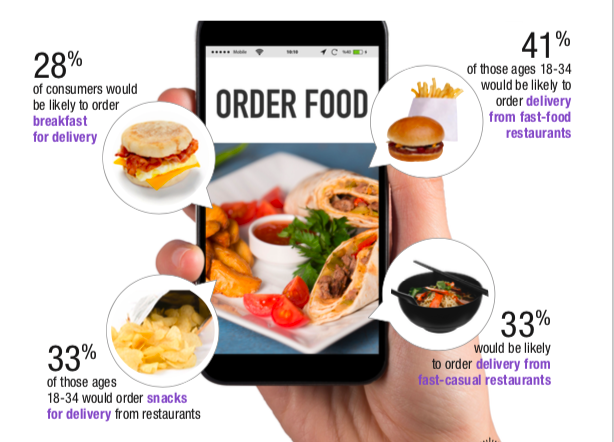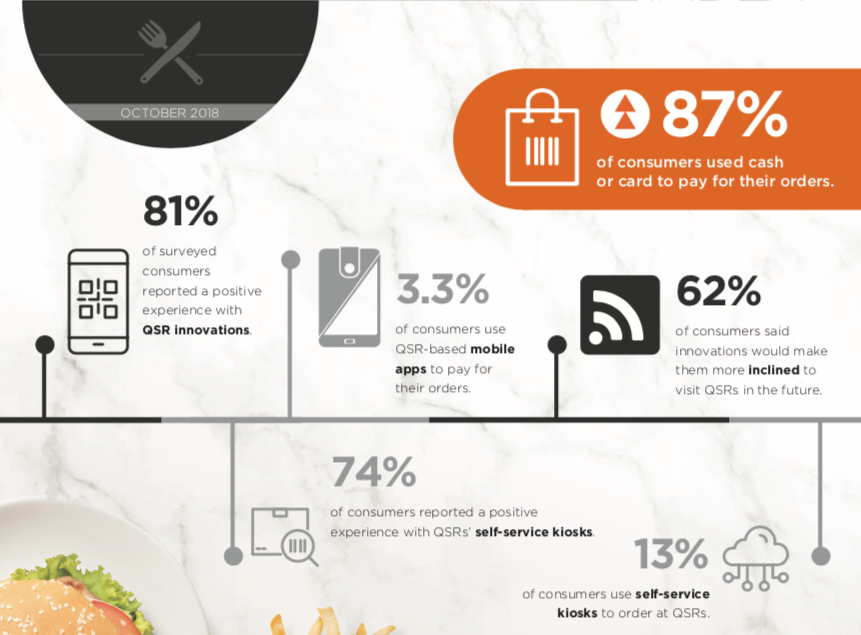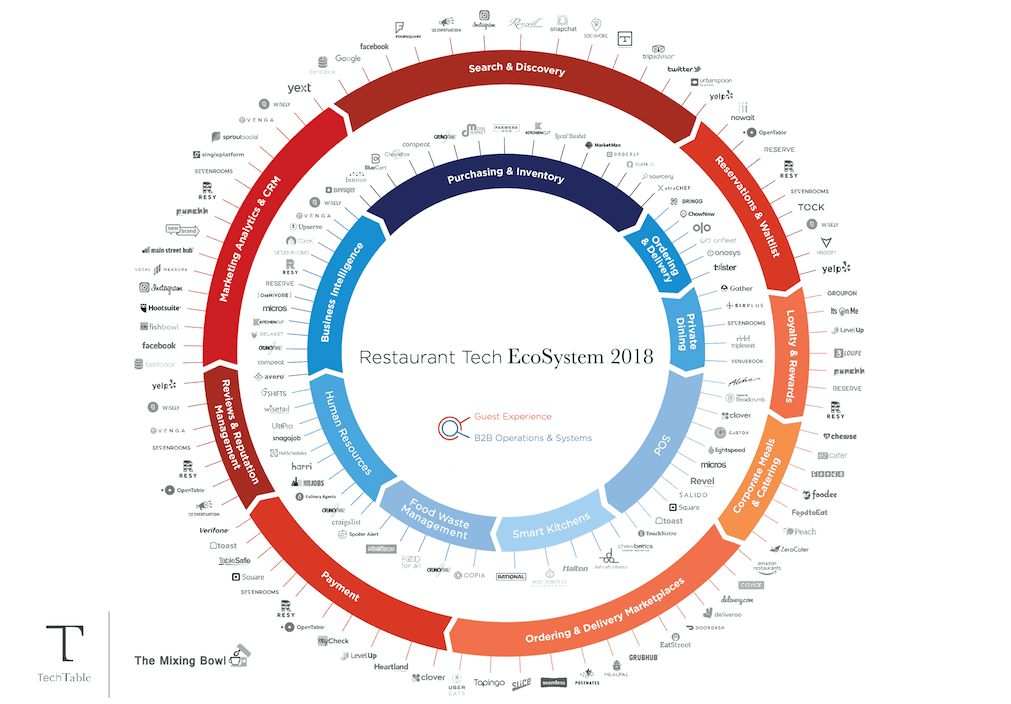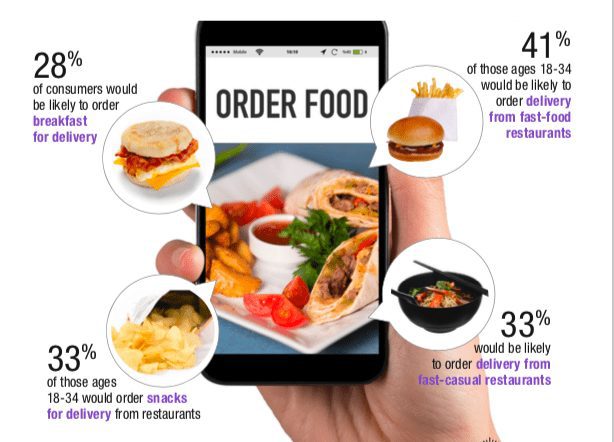Introduction
The way consumers interact with restaurants is evolving rapidly. They want to order anytime, anywhere; they want high-quality food but don’t want to wait; and, they’re eating out less but ordering in more. Fast Casual and Quick Service restaurants are struggling to stay competitive and manage the dizzying array of channels and platforms needed to accommodate these trends. As a result, implementing the right technology ecosystem and processing orders efficiently is critical if restaurants want to optimize the guest experience, grow revenue, and improve operations.
This white paper discusses how consumer behaviors and expectations are changing the restaurant industry, why omni-channel restaurant operations are so important, and how to build an omni-channel ecosystem to position your restaurant for success. It presents 8 key considerations for choosing a modern POS to support your omni-channel efforts, including an evaluation checklist to use with potential vendors.
The New Omni-Channel Playing Field for Restaurants
According to a Technomics 2018 report, delivery via third-party apps accounted for $5B in sales in the first half of 2018, a 54.6% increase when compared to the same time period in 2017. In fact, over 62% of customers had food delivered more than once a week in Q1 2018. And, as seen in the graphic below, consumers are interested in a wide range of delivery options, especially from Fast Casual and Quick Service restaurants.

Source: Technomic, Diving into Delivery, 2018
The need for innovation in Quick Service and Fast Casual restaurants does not stop at delivery. In their most recent Restaurant Readiness Index, Pymnts.com has found that technological innovations play a significant role in the positive experience consumers have with chains. Additionally, 62% of consumers surveyed stated that innovations, such as online/app ordering, digital wallets, and loyalty programs, would make them more inclined to visit in the future.

Source: Pymnts.com Restaurant Readiness Index, 2018
As guests increase the ways in which they interact with chains, such as third-party delivery apps, restaurant websites / mobile apps, and in-store kiosks, the level of sophistication needed to process orders efficiently while maintaining a consistent customer experience is high. It’s a new playing field for restaurants and the table stakes are rising.
Restaurants are adapting by laying the digital foundation for transactions and data capture, but much of that data remains silo-ed across disparate systems. Indeed, the restaurant tech stack often includes upwards of 16 separate tools based on the categories identified in the Tech Table / Mixing Bowl Restaurant Tech Landscape as seen in the diagram below.

Source: TechTable, The Mixing Bowl Restaurant Tech EcoSystem 2018
Restaurant IT Spending Rises to Meet Omni-Channel Demands
As reported by Hospitality Tech, the rise in technological innovation and a shift to a digital and data-driven paradigm has led to a 47% increase in restaurant spending. One of the reasons for this rise is that almost half of the restaurants surveyed felt that they were lagging behind their competitors when it came to their use of data / analytics and their ability to digitally engage their customers. As such, there is expected to be a 56% increase in IT budgets through 2018 as restaurants look to transition to a modern POS and become tomorrow’s leaders instead of today’s laggards.

Source: HospitalityTech, Restaurant Technology Study 2018
Solving the Challenge with the Point of Sale as the “Central Hub”
Given that all transactions pass through the POS, it’s critical that the right platform be in place to manage this new digital ecosystem. Unlocking POS data to further understand guest behavior and patterns on both a micro and macro level is a major opportunity. A few years ago, operators were unable to segment and entice customers with loyalty rewards based on their past orders. Fast Casual and Quick Service restaurants relied on survey data and outdated demographic research. Now, as the industry focuses on guest behavior and personalization, operators shouldn’t be limited to a single order profile view of the guest. Instead, their view should include all channels including in-store, kiosk, drive-thru, web, and mobile to get a holistic view of the customer.
Based on today’s market needs, restaurants need a solid ecosystem in place to stay competitive and meet consumer’s demands. Unfortunately, very few existing POS vendors offer a truly enterprise-grade, omni-channel platform that lets restaurants aggregate data across all of their systems and effectively manage their entire operations. While some allow operators to measure and manage operational efficiencies within individual systems, they do not enable restaurants to create holistic customer views and leverage insights to optimize or automate efforts based on that intelligence. A modern POS can actualize this idea by integrating all channels into the same underlying dataset so that there is no need for data synchronization between different systems as it is already the same data. Three of the key benefits achieved with a fully integrated POS that serves as the “Central Hub” in a restaurant are:
Consistency Across Channels & Devices
An integrated POS ensures that menus and prices are exactly the same across channels, that the same discount coupon will work regardless of where a customer places an order, and a customer’s preferences like gluten-free and favorite orders will show up every time in a consistent manner.
Reduced Configuration Time
Working from a common dataset, an integrated POS dramatically reduces configuration time because it allows you to set things up once for all of your items, pictures, and prices. Additionally, having a common dataset help to prevent things from quickly becoming out of date.
Shared but Customizable Data
An integrated POS lets you get up and running quickly with general settings, as well as configure unique settings across channels where you want to customize menus and the order process. For example, ice cream should only be sold in store, not orderable online.
Qu – A POS Solution to Meet Omni-Channel Needs Today and Beyond
With a focus on Fast Casual and Quick Service restaurants, Qu understands the challenges that restaurants face and has built a POS solution that can help chains evolve alongside their guests – today and beyond. With an enterprise-scale, cloud-based platform that is fast, flexible, and forward-thinking, Qu delivers on the eight key areas you should expect from a modern POS solution, including:
1. Enterprise Administration & Scalability
Whether you have a handful of restaurants or hundreds, it’s essential to create a solid foundation with your POS configuration. This starts with your menu. With some POS systems, you create a menu for each location, each channel, that are copies and variations of each other. When you want to change out an item, you have to make that change in many different places, which is cumbersome to manage and leads to inaccuracies across locations and channels. With Qu, you create one enterprise menu, and hierarchical configurations for different states, franchisees, etc. When you change a menu at the parent level, then all the children menus automatically reflect the change. You can create multiple hierarchies and add exceptions at any level along four dimensions: location, meal period (breakfast, lunch, happy hour, dinner, etc.), order type (dine-in, carryout, delivery), and order channel (POS, kiosk, online, app, phone).
2. Cloud Deployed, Not Cloud Dependent
Having a central repository for administration, reporting, and analytics is critical, but you also want to make sure that in-store operations can continue even without the internet or network. With Qu, all configuration data is cached locally, so kiosks can continue to take orders and sync later to the cloud. Each terminal has its own configuration cache and transaction cache, so even if the internet or network goes down they don’t need to communicate with each other to remain operational. We also offer the option to take offline credit card transactions, with a configurable limit that will allow you to proceed offline. A modern POS will be cloud deployed, but not cloud dependent – so you can continue running your business anytime, anywhere.
3. Best-in-Class Integrations
As your POS shifts into the “central hub” position in your tech stack, integration capabilities with surrounding tools become tantamount. Seamless integration with delivery apps, for example, enables restaurants to process those orders the same way as orders placed over the phone or on the website. No more printing orders from Grubhub, UberEats, and Eat24 from three separate iPads, in three different formats, and expecting accurate and timely order processing. With Qu, orders from third- party apps can process exactly like every other order, saving you time and resources while increasing order accuracy and customer experience.
Not only should your POS become the system of record, where surrounding tools are feeding data into it, but it should also be able to send data back out to other tools. For example, you could have your staff clock in and out directly at each POS terminal, which would then sync back to your HR system where you have more advanced scheduling and reporting capabilities. At Qu, we believe in choosing best-in-class tools specific for each facet of your restaurant operations. Thus, we’ve built a stable, unified, API-driven platform with integrations to dozens of tools so you’re free to partner with the technology companies of your choice.
4. Conversational Ordering
To optimize speed of service, it helps to fit as much information on one screen as possible. A modern POS will work with restaurants to optimize screens for different devices – whether it be POS terminals, kiosks, or mobile app to make it easy to see all of the options. It will also be flexible to accept inputs in whatever order the customer makes their selection. Do they start with the latte, or the size, or the flavor? Every customer is different, and a POS shouldn’t force the flow of how people order what they want. If the flow is forced, cashiers can only focus on one item at a time, which significantly reduces the speed of ordering and is prone to errors. Qu’s single screen, flexible input flow also helps cashiers to quickly handle changes when a customer changes their mind while ordering. We also keep all of the options available at all times, so if a customer asks whether there are onions on a particular sandwich, you don’t have to go back and see – it’s all right there. Smart gestures like swiping also feel familiar to employees, which reduces their ramp up time.
5. Simplicity
Beyond its core functionality, administration and integration capabilities, a modern POS should be simple to install, simple to train, and simple to use. The POS is the workhorse of a restaurant’s tech stack, and it can make everything else easier, or it can hold you back. At Qu, we’ve worked hard to bring you a product that your staff will love based on our in-depth knowledge of restaurant operations. Once you come onboard as a customer, we’ll walk you through the initial configuration through permissions, roles, and reports, and train your entire team onsite. We make it easy to maintain as you grow your business and add locations, and we’re there to support you every step of the way.
6. Rugged, Restaurant-Ready Hardware
While the simplicity of iPad-only systems may be tempting, restaurant hardware needs to be able to withstand hot/cold environments, spills, and heavy usage well beyond what’s expected of consumer devices. At Qu, we have ruggedized hardware built especially for the demands of a restaurant. We test all of our hardware extensively, so you can be confident using it in the freezer and the fry station and everything will still work. Qu hardware has a track record of lasting 4-5 years, unlike iPads which are not restaurant ready and do not last long. We offer the best combination of ruggedness and price to ensure reliability.
7. Payment Agnostic
Payment processing costs are a critical factor when it comes to the economics of a restaurant. Selecting the cash and credit card processing platform that best meets the needs and cost structure of your restaurant is critical. At Qu, we give you the flexibility to the payment processor you’d like, which means you’re not locked into any long-term contracts, there are no hidden fees, and you get the most value.
8. Enterprise Stability & Flexibility
Whether UNIX, Windows, iOS, or Android, the operating system your POS runs on will impact your hardware decisions as well the ease of administration and scalability. Qu runs on Windows and works on multiple different hardware platforms, unlike iOS which only works on iPads. In our opinion, Windows offers the best enterprise software management capabilities, especially for growing restaurant chains. This is because it provides operational reliability and flexibility in terms of hardware, so you can choose the right hardware for the right purpose.
Evaluation Checklist for Selecting a Modern POS
In summary, when it comes to creating an omni-channel ecosystem for your restaurant, having a POS that can serve as a central hub for restaurant operations is critical. However, not every POS can be fully integrated and serve as the central hub. As such, before investing money on a platform, it is critical to ensure that the POS you select will meet the needs of your restaurant not only today but in the future. Below are some things to consider before choosing and purchasing a POS platform:
- Is your POS platform enterprise friendly and scalable to the needs of your restaurant?
- Does the loss of internet impact your POS’ ability to manage store operations & credit card processing?
- Does your POS offer APIs to integrate with the best-in-class tools you are already using?
- Does your POS offer cashiers conversational ordering and optimize speed of service?
- Is it easy to install and receive ongoing support for your POS platform?
- Does your POS provide ruggedized hardware designed specifically for restaurants?
- Does your POS platform work with the payment processor platform best suited for your chain?
- Does your POS platform offer the stability needed to support your restaurant operations?
About Qu™
Qu™, formerly Gusto®, is going beyond traditional Point of Sale (POS) technology with a singular focus on Fast Casual and Quick Service restaurant chains. Leveraging an API-first approach and a core suite of omni-channel ordering solutions, Qu delivers an enterprise-scale, cloud-based POS solution that’s fast, flexible, and forward-thinking, making it easy to implement, easy to use, and easy to afford. Improved guest experience, best-in-class integrations, centralized enterprise management, and payment processor choice are some of the reasons leading restaurant chains choose Qu to help them move faster, stay nimble, and increase profits. Learn more at qubeyond.com or email sales@qubeyond.com.
